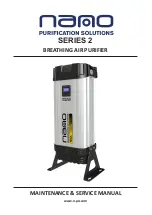
Installation
Climate 5000i – 6721824787 (2021/09)
56
3.4
Pipework connection
3.4.1
Connecting refrigerant lines to the indoor and outdoor unit
CAUTION
Discharge of refrigerant due to leaky connections
Refrigerant may be discharged if pipe connections are incorrectly
installed.Reusable mechanical connectors and flared joints are not
allowed indoors.
▶ Tighten flared connections only once.
▶ Always make new flared connections after loosening.
Copper pipes are available in metric and imperial sizes, the flare nut
thread is however the same. The flared fittings on the indoor and outdoor
unit are intended for imperial sizes.
▶ When using metric copper pipes, replace the flare nuts with nuts of a
suitable diameter (
Tab. 7).
▶ Determine pipe diameter and length (
Page 54).
▶ Cut the pipe to length using a pipe cutter (
Fig. 11).
▶ Deburr the inside of the pipe at both ends and tap to remove swarf.
▶ Insert the nut onto the pipe.
▶ Widen the pipe using a flaring tool to the size indicated in the tab. 7.
It must be possible to slide the nut up to the edge but not beyond it.
▶ Connect the pipe and tighten the screw fitting to the torque specified
in the tab. 7.
▶ Repeat the above steps for the second pipe.
NOTICE
Reduced efficiency due to heat transfer between refrigerant pipes
▶ Thermally insulate the refrigerant lines separately.
▶ Fit the insulation on the pipes and secure.
Table 7 Key data of pipe connections
3.4.2
Connecting condensate pipe to the indoor unit
The condensation catch pan of the indoor unit has two connections. A
condensate hose and bung are mounted on these connections at the
factory and can be replaced (
Fig. 12).
▶ Only route the condensate hose with a slope.
3.4.3
Checking tightness and filling the system
Checking tightness
Observe the national and local regulations when carrying out the
tightness test.
▶ Remove the caps on the three valves (
Fig. 18, [1], [2] and [3]).
▶ Connect the Schrader opener [6] and pressure gauge [4] to the
Schrader valve [1].
▶ Screw in the Schrader opener and open the Schrader valve [1].
▶ Leave valves [2] and [3] closed and fill the system with nitrogen until
the pressure is 10 % above the maximum operating pressure
(
▶ Check whether the pressure is still the same after 10 minutes.
▶ Discharge the nitrogen until the maximum operating pressure is
reached.
▶ Check whether the pressure is still the same after at least 1 hour.
▶ Discharge nitrogen.
Filling the system
NOTICE
Malfunction due to incorrect refrigerant
The outdoor unit is filled with R32 refrigerant at the factory.
▶ If refrigerant needs to be topped up, only use the same refrigerant.
Do not mix refrigerant types.
▶ Evacuate and dry system with a vacuum pump (
Fig. 18, [5]) until
the pressure is approx. −1 bar (or approx. 500 microns).
▶ Open the valve at the top [3] (liquid side).
▶ Use a pressure gauge [4] to check whether the flow is unobstructed.
▶ Open valve at bottom [2] (gas side).
The refrigerant is distributed round the system.
▶ Afterwards, check the pressure ratios.
▶ Unscrew the Schrader opener [6] and close the Schrader valve [1].
▶ Remove the vacuum pump, pressure gauge and Schrader opener.
▶ Reattach the valve caps.
▶ Reattach the cover for pipe connections to the outdoor unit.
External diameter of
pipe Ø [mm]
Tightening torque [Nm]
Flared opening diameter
(A) [mm]
Flared pipe end
Pre-assembled flare nut
thread
6.35 (1/4")
18-20
8.4-8.7
3/8"
9.53 (3/8")
32-39
13.2-13.5
3/8"
R0.4~0.8
A
45°± 2
90°± 4
Содержание CL5000i 26 E
Страница 266: ......
Страница 267: ......
Страница 268: ...Bosch Thermotechnik GmbH Junkersstrasse 20 24 D 73249 Wernau www bosch thermotechnology com ...
















































